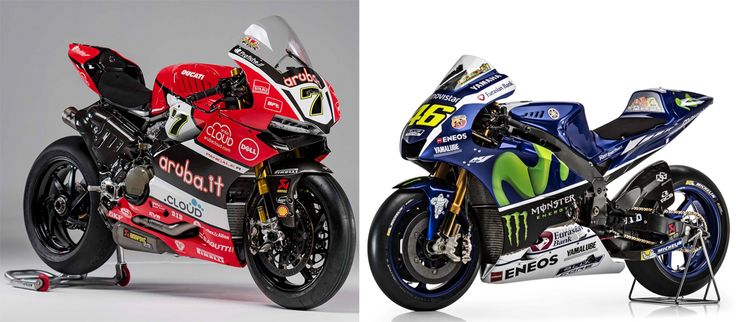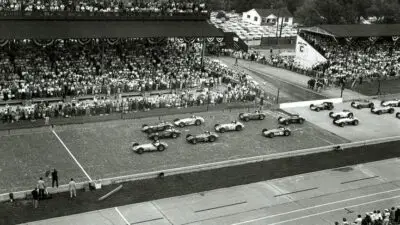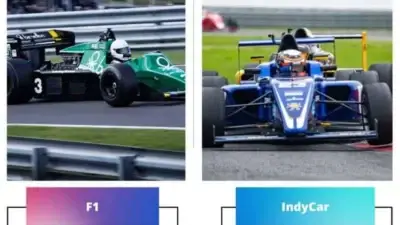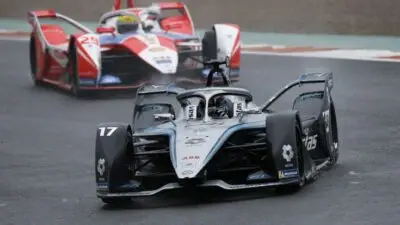Motorcycle racing offers two premier championships that captivate fans worldwide: MotoGP and World Superbike (WSBK). While both feature high-speed racing on two wheels, they differ in fundamental ways that shape their competition and appeal. The main difference between MotoGP and World Superbike is that MotoGP uses prototype motorcycles designed exclusively for racing, while WSBK uses modified production bikes based on models available to consumers.
These racing series showcase different approaches to motorcycle competition. MotoGP represents the absolute pinnacle of motorcycle technology with purpose-built prototypes that aren’t available to the public. In contrast, World Superbike machines are slower, heavier and much more like the bikes you see on the road. This distinction affects everything from race strategies to the skills riders need to succeed.
The two championships also differ in their season structure and race formats. MotoGP runs a considerably longer season, almost double that of WSBK. Meanwhile, WSBK features multiple races per weekend, giving fans more action and riders more opportunities to demonstrate their skills across different conditions.
Key Takeaways
- MotoGP uses prototype race-only motorcycles while World Superbike uses modified production bikes available to consumers.
- WSBK runs multiple races per weekend compared to MotoGP’s single Sunday race format.
- MotoGP represents the technological pinnacle of motorcycle racing while WSBK demonstrates what’s possible with consumer motorcycle models.
MotoGP vs. World Superbike: Core Distinctions
MotoGP and World Superbike represent two premier motorcycle racing categories with fundamental differences in bike specifications, racing formats, and overall positioning in motorsport. These distinctions shape everything from the technology used to the racing experience for fans.
Overview of Both Championships
MotoGP stands as the pinnacle of motorcycle racing, featuring the most advanced technology and prototype machines built specifically for racing. Founded in 1949, it represents the oldest motorsport world championship, operating under the governance of the Fédération Internationale de Motocyclisme (FIM).
World Superbike Championship (WSBK or SBK) began in 1988 and focuses on production-based motorcycles. Unlike MotoGP, these bikes start as models available to consumers before being modified for racing competition.
The racing formats differ significantly. MotoGP hosts a single race on Sundays (with Sprint races recently added), while WSBK features two main races per weekend, giving fans more racing action to enjoy.
Both championships race at world-class circuits, though they don’t always share the same venues. In Britain, for example, WSBK uses Donington while MotoGP races at Silverstone.
Prototype Machines vs. Production Motorcycles
The most definitive difference between MotoGP and Superbike lies in the motorcycles themselves. MotoGP bikes are exclusive prototypes built solely for racing and unavailable for public purchase. These machines are:
- Lighter (minimum weight of 157 kg)
- More powerful (over 270 horsepower)
- Equipped with cutting-edge electronics and pneumatic valves
- Built with specialized carbon brakes and seamless gearboxes
In contrast, World Superbike machines begin as production motorcycles that consumers can buy. They undergo modifications for racing but must maintain their core production characteristics. These bikes are:
- Heavier (minimum weight of 168 kg)
- Less powerful (around 230 horsepower)
- More similar to street bikes
- Limited by regulations to maintain connection to production models
Position in the Motorcycle Racing World
MotoGP occupies the absolute top tier of motorcycle racing, often described as the “Formula 1 of motorcycle racing.” It attracts the largest global audience, highest sponsorship deals, and generally the most elite riders in the sport.
World Superbike holds a strong but secondary position in the global racing hierarchy. Its focus on production-based machines creates a different appeal – showing what’s possible with motorcycles consumers can actually purchase.
The financial ecosystem differs significantly between the championships. MotoGP teams operate with substantially larger budgets, more extensive technical staff, and higher rider salaries compared to WSBK teams.
Career paths often intersect between the championships, with riders sometimes moving between series. Some use WSBK as a stepping stone to MotoGP, while others transition to Superbike after MotoGP careers.
Motorcycles and Technology in Each Series
The machines used in MotoGP and World Superbike represent two fundamentally different philosophies in motorcycle racing. One showcases cutting-edge prototype technology while the other demonstrates what production motorcycles can achieve at their limit.
MotoGP Prototype Bike Features
MotoGP bikes are purpose-built prototypes that cannot be purchased by the public. These machines feature 1000cc engines producing over 270 horsepower and can reach speeds exceeding 360 km/h (220 mph).
Each motorcycle is a unique creation, designed exclusively for racing with no road-legal components. The bikes weigh approximately 157 kg (346 lbs), making them incredibly light for their power output.
MotoGP machines utilize advanced electronics including sophisticated traction control, anti-wheelie systems, and launch control. The seamless-shift gearboxes allow riders to change gears without closing the throttle.
Carbon brakes provide exceptional stopping power, while pneumatic valve systems enable engines to reach extremely high RPMs. Teams can spend unlimited amounts on development, creating truly bespoke racing machines.
World Superbike Production-Based Machines
World Superbike (WSBK) motorcycles are derived from production models available to consumers. These bikes begin as standard production motorcycles that are then modified for racing.
The regulations require manufacturers to produce a minimum number of road-legal versions before they can be homologated for racing. WSBK machines typically generate around 230 horsepower and reach top speeds of about 320 km/h (200 mph).
These motorcycles retain their original frames and engine cases, though internal components can be modified within strict regulations. WSBK bikes are heavier than MotoGP machines, weighing approximately 168 kg (370 lbs).
The series uses steel brakes rather than carbon, and the electronics packages, while sophisticated, are more restricted than in MotoGP. This creates racing that more closely resembles what consumers might experience on enhanced street bikes.
Technological Advancements and Restrictions
Both series enforce different technological restrictions to maintain competitive balance. MotoGP employs a single ECU supplier and standardized software across all teams, but allows greater freedom in chassis and engine development.
Fuel capacity in MotoGP is limited to 22 liters, forcing engineers to create incredibly efficient engines. The series also restricts testing days and engine allocation throughout the season to control costs.
WSBK has stricter modification rules regarding engine internals, electronics, and chassis components. The series uses a price cap system on certain components to prevent escalating costs.
Aerodynamics represent a significant difference between the series. MotoGP bikes feature complex winglets and aero bodies, while WSBK maintains closer ties to production models with more limited aerodynamic modifications.
The technological gap between the series is substantial, with MotoGP machines consistently faster by several seconds per lap at shared circuits, demonstrating the performance difference between prototype and production-based racing.
Race Formats and Season Structure
MotoGP and World Superbike employ distinctly different race formats and season structures. These differences affect how races unfold, how championships are decided, and the overall fan experience throughout the racing calendar.
MotoGP Race Weekend and Classes
MotoGP weekends feature three different classes of racing: MotoGP, Moto2, and Moto3. The premier MotoGP class represents the pinnacle of two-wheel racing with purpose-built prototypes.
Each MotoGP weekend now includes a Sprint race on Saturday, covering approximately 50% of the full race distance. This short-format race awards half the points of Sunday’s main event. The main Grand Prix takes place on Sunday and typically lasts around 45 minutes.
Practice sessions begin on Friday with Free Practice, followed by qualifying sessions on Saturday that determine grid positions. The qualifying format uses a Q1/Q2 system where the fastest riders advance to compete for pole position.
All three classes follow similar weekend structures, providing fans with multiple racing categories to enjoy throughout the event.
World Superbike Race Weekend and Classes
World Superbike (WSBK) features a more condensed class structure with WorldSBK as the premier category, supported by WorldSSP (Supersport) and WorldSSP300 classes.
The WSBK weekend format is unique with three full-length races for the main class. This includes Race 1 on Saturday, the shorter Superpole Race on Sunday morning, and Race 2 on Sunday afternoon. This gives fans more opportunities to see the top riders compete.
The Superpole Race is a 10-lap sprint that determines part of the starting grid for Race 2. It offers fewer championship points than the full-length races but adds strategic importance to the weekend.
Qualifying takes place through a Superpole session, a high-pressure time trial where riders get limited attempts to set their fastest lap. This format creates intense moments as riders push for optimal grid positions.
Points and Championship Systems
MotoGP uses a points system where the top 15 finishers receive points (25 for first place down to 1 point for 15th). Sprint races award half points with only the top 9 riders scoring.
World Superbike employs a more complex system:
- Full-length races: 25 points for 1st place down to 1 point for 15th
- Superpole Race: 12 points for 1st place down to 1 point for 9th
This difference in points distribution means WSBK riders have three opportunities to score per weekend, creating more volatility in championship standings.
Both championships crown individual riders’ champions, but WSBK also places more emphasis on manufacturer championships. Team championships exist in both series but carry different prestige levels.
Calendar and Circuits
The MotoGP calendar is considerably longer with 22 rounds in 2025, running from March to November. It features races across five continents, making it a truly global championship.
WSBK has a more compact schedule with only 12 rounds in 2025, starting in February at Phillip Island, Australia, and concluding in October in Spain. This creates a shorter but still intense championship battle.
Both series share some iconic circuits like Phillip Island and Catalunya, but MotoGP visits more purpose-built Grand Prix tracks. WSBK tends to race at circuits with more varied character, including some tracks that are less specialized for motorcycle racing.
The calendar structure difference creates distinct rhythms for each championship, with MotoGP having a more relentless schedule compared to the more spaced-out WSBK rounds.
Rider Skills and Team Dynamics
The human element in motorcycle racing creates distinct differences between MotoGP and World Superbike. The riders’ backgrounds, team structures, and riding techniques all contribute to the unique character of each championship.
Rider Backgrounds and Career Progression
MotoGP riders typically climb through a structured ladder system. Most elite riders progress from Moto3 to Moto2 before reaching the premier class. This path helps develop specialized skills needed for prototype machines.
World Superbike (WSBK) attracts riders from diverse backgrounds. Many competitors come from national superbike championships or even transition from MotoGP. This creates a mix of riding styles and approaches to racing.
The career longevity often differs between series. WSBK riders tend to have longer careers, with some competing well into their 30s or even 40s. MotoGP’s intense physical demands and competition for seats can lead to shorter careers at the top level.
Team Structures and Factory Involvement
MotoGP features factory-backed teams like Honda, Yamaha, Ducati, and KTM that provide cutting-edge machinery. These teams employ large engineering staffs and have substantial budgets.
Team spending in MotoGP is largely unrestricted, while WSBK has limitations on spending for bikes, riders, and R&D. This creates different team dynamics and approaches to development.
Satellite teams in MotoGP operate with support from manufacturers but with smaller budgets. In WSBK, private teams can sometimes challenge factory efforts due to the production-based regulations that limit extreme development.
Kawasaki, while absent from MotoGP, maintains a strong factory presence in WSBK. Their focused effort has led to multiple championships.
Rider Techniques and Adaptation
MotoGP and WSBK require different riding approaches. Former MotoGP rider Remy Gardner, who moved to WSBK, noted it’s “a completely different style of riding”.
MotoGP riders master extreme techniques specific to prototype machines. They deal with sophisticated electronics, aerodynamics, and carbon brakes that require specialized skills.
WSBK competitors excel at adapting to production-based motorcycles. They must be versatile as the bikes have different characteristics than MotoGP prototypes.
Riding positions differ between the series. MotoGP riders adopt more extreme body positions due to the higher speeds and different handling characteristics of their purpose-built machines.
Body size plays a role too. Smaller, lighter riders often have an advantage in MotoGP, while WSBK accommodates a wider range of physiques due to the production-based nature of the machines.
Technology Transfer and Innovation
Racing technology developed for high-performance competitions frequently makes its way to everyday motorcycles. MotoGP and World Superbike series serve as testing grounds for innovations that eventually benefit ordinary riders.
From MotoGP to Consumer Motorcycles
MotoGP’s prototype machines are laboratories for cutting-edge technology. These bikes test innovations years before they reach production models. Advanced electronics like traction control, anti-wheelie systems, and ride-by-wire throttles all began in MotoGP.
Braking systems have evolved significantly due to racing development. Carbon brakes used in MotoGP led to improved composite materials in consumer motorcycle brakes.
Aerodynamic winglets, first controversial in MotoGP, now appear on high-end street bikes like the Ducati Panigale V4 and Honda CBR1000RR-R. Even engine designs benefit from racing research, with crossplane crankshafts and variable valve timing making the leap from track to street.
Impact on Motorcycle Market
The technology transfer from racing creates a trickle-down effect in the motorcycle industry. Manufacturers use racing success as marketing tools, highlighting how their production bikes benefit from race-proven technology.
WorldSBK has a more direct impact on consumer motorcycles since its regulations require production-based machines. Innovations tested in WorldSBK can move to showroom models much faster than those from MotoGP.
This racing-to-retail pipeline drives competition among manufacturers to develop better motorcycles. Consumers benefit from safer, more efficient, and better-performing bikes without needing to understand the complex engineering behind them.
Japanese and European manufacturers often emphasize their racing heritage when marketing premium motorcycles, creating brand loyalty among enthusiasts who follow racing.
Fan Experience and Global Reach
Both MotoGP and World Superbike offer unique experiences for motorcycle racing enthusiasts, though they differ in accessibility, media coverage, and atmosphere at events.
Audience Engagement and Media Coverage
MotoGP enjoys broader global media coverage, with races broadcast on major networks worldwide. The championship has invested heavily in digital platforms, offering fans comprehensive apps, live timing, and social media content to engage with the sport.
Superbike races typically appear on channels like Eurosport and ITV4 in the UK, providing good coverage despite having a smaller media footprint than MotoGP. The series has a dedicated and passionate fan base, even if it lacks MotoGP’s global reach.
Both championships have embraced digital transformation to connect with fans. MotoGP’s VideoPass and World Superbike’s VideoPass services allow viewers to watch races live or on-demand, bringing the excitement to audiences worldwide.
Worldwide Popularity and Event Atmosphere
MotoGP represents the pinnacle of motorcycle racing, attracting massive crowds at iconic venues like Mugello, Valencia, and Phillip Island. Race weekends often draw 100,000+ spectators, creating an electric atmosphere.
World Superbike machinery maintains a closer link to production motorcycles, making it more relatable for many fans who ride similar bikes on the street. This connection creates a unique bond between spectators and competitors.
WSBK events typically offer more relaxed paddock access, allowing fans closer interaction with riders and teams. Many enthusiasts appreciate this approachability compared to the more corporate atmosphere of MotoGP.
Both series feature passionate followings in Europe, particularly in Italy and Spain. However, MotoGP has made significant inroads in Southeast Asia, especially Indonesia and Thailand, where motorcycle culture thrives.
Frequently Asked Questions
MotoGP and World Superbike racing differ in multiple technical aspects and competition formats. These differences affect everything from motorcycle specifications to race structure and team budgets.
What are the differences in regulations between MotoGP and World Superbikes?
MotoGP features prototype motorcycles built specifically for racing that aren’t available to the public. These bikes are custom-made with cutting-edge technology and specialized parts.
World Superbike (WSBK) uses production-based motorcycles that consumers can purchase. While they’re modified for racing, the core bike must be based on commercially available models with at least 1,000 units produced.
WSBK regulations require more standardized components and limited modifications, while MotoGP allows for more extensive technological innovation and customization.
How do the top speeds of MotoGP bikes compare with those of World Superbike machines?
MotoGP bikes typically achieve higher top speeds than their WSBK counterparts. Modern MotoGP machines can reach speeds exceeding 350 km/h (217 mph) on suitable tracks.
World Superbike machines are generally slower and heavier than MotoGP bikes. They typically reach maximum speeds around 330 km/h (205 mph).
This speed difference stems from MotoGP’s prototype design freedom and advanced aerodynamics that prioritize performance over production viability.
Can you explain the disparity in horsepower between MotoGP and World Superbike motorcycles?
MotoGP bikes produce approximately 280-290 horsepower from their 1000cc engines. This extraordinary power-to-weight ratio allows for explosive acceleration and the extreme speeds seen in competition.
WSBK motorcycles generate around 230-250 horsepower, which is still impressive but noticeably less than MotoGP bikes. This power difference is primarily due to MotoGP’s specialized engines and components.
The performance gap exists because MotoGP focuses solely on racing performance, while Superbike engines must maintain some connection to their production counterparts.
What are the engine capacity limits for MotoGP and World Superbike classes?
MotoGP rules currently limit engines to 1000cc with a maximum of four cylinders. The regulations also specify that these engines must be four-stroke.
World Superbike operates with more varied engine capacity limits based on cylinder count. Generally, four-cylinder bikes are limited to 1000cc, while twin-cylinder bikes may run up to 1200cc.
These capacity differences reflect each series’ approach: MotoGP’s standardized prototype formula versus WSBK’s production-based formula that accommodates different motorcycle designs.
In terms of technology and costs, how do MotoGP and World Superbike teams differ?
MotoGP represents the pinnacle of motorcycle racing technology, with annual team budgets that can exceed $50 million for factory teams. Teams employ cutting-edge electronics, pneumatic valves, seamless gearboxes, and carbon brakes.
World Superbike operates with substantially lower budgets, typically ranging from $5-15 million for top teams. The series uses more standardized electronics and restricted technical development to control costs.
This cost difference makes WSBK more accessible for private teams and smaller manufacturers compared to the manufacturer-dominated MotoGP grid.
What differentiates the race formats and championship points systems of MotoGP and World Superbikes?
MotoGP features a single main race per event weekend, with points awarded to the top 15 finishers (25 points for first place down to 1 point for 15th). The introduction of Sprint races in 2023 added a shorter Saturday race with reduced points.
WSBK has a distinctive three-race format per weekend. This includes two full-length main races (Race 1 and Race 2) and a shorter Superpole Race, all awarding championship points.
MotoGP’s season is considerably longer with approximately 20 rounds, while WSBK typically features around 12 rounds, creating different championship dynamics and strategic approaches.











